End Procrastination Now! (6 page)
Read End Procrastination Now! Online
Authors: William D. Knaus

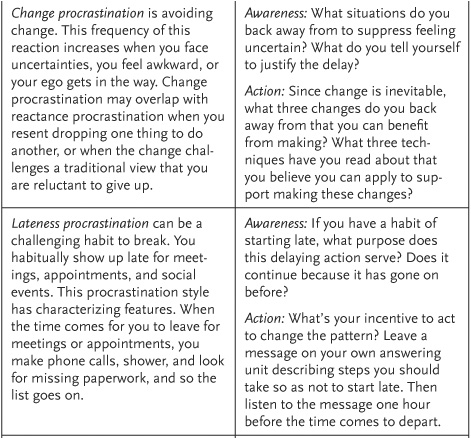
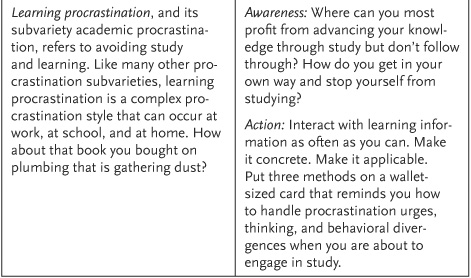
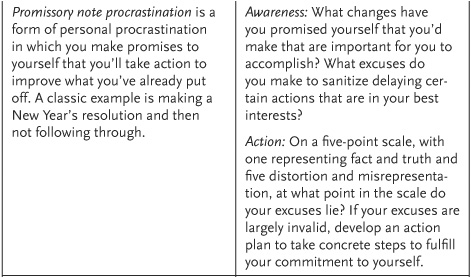
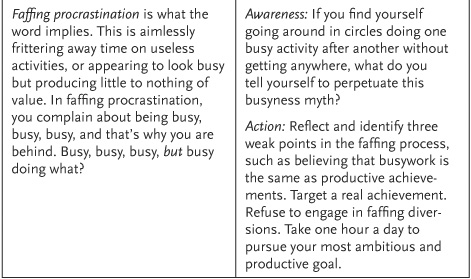
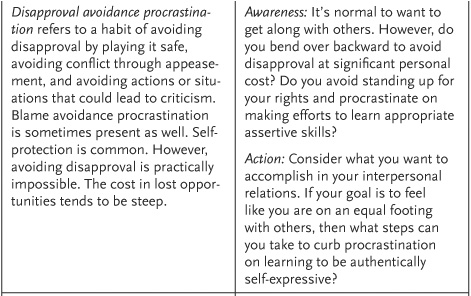
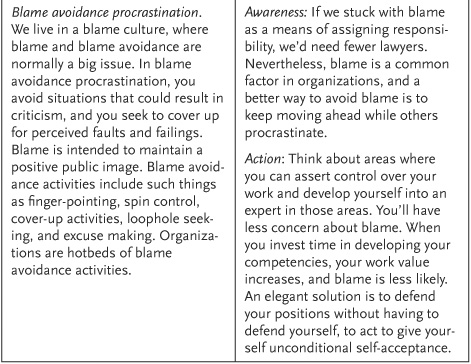
Procrastination styles may surface in different contexts and have some unique twists. However, the underlying procrastination processes are roughly comparable. Thus, when you understand this underlying process, you can use this knowledge to address procrastination across a variety of contexts and styles.
Acknowledging a procrastination habit is a critical step on the path to change. Having some preexisting knowledge of what lies on the path is better yet. You'll know where to look and what to target. Even if you don't have an interest in tackling procrastination now, understanding how the process works may later lead you to experiment with counter-procrastination ideas and techniques.
Moving from a procrastination path to a productive one often starts with a shift
from
feeling absorbed in procrastination process thinking, feeling, and behaving
to
a self-observant problem-solving perspective. When you are self-absorbed, you draw inward. You're concerned about how you feel, how you might look to others, or whether you are perfect enough. When you are absorbed in such anxious thoughts and feelings, you may find it hard to keep your productive goals in focus. Procrastination thoughts may linger as you languish. This inward view finds outward expression in procrastination.
A self-observant way of knowing and doing involves a radical shift from an inward to a reality perspective that is elegant in its simplicity:
1. Monitor your thoughts, feelings, and actions and do a perception check.
2. Take a scientific approach, in which you rely on observation and draw evidence-based inferences and conclusions.
3. Predict the outcome of playing out different scenarios.
4. Act rationally to achieve enlightened positive goals.
5. Learn from planned procrastination countermeasures and apply new learning.
On a case-by-case basis, you can make a radical shift from a self-absorbent to a self-observant perspective. Unlike learning to read, where it takes several years to get the basics and to build from there, you can start this shift right away. However, progressive mastery of procrastination is a process that extends over a lifetime but gets simpler and easier in time. As the rewards for your self-observant efforts pile up, you'll have added incentive to continue in this do-it-now way.
A procrastination log is an awareness tool for tracking what you do when you procrastinate. Logging what you think, how you feel, and what you do as you procrastinate promotes metacognitive awareness. This is your ability to think about your thinking and to make connections between your thoughts, emotions, behaviors, and results. If you prefer a more freewheeling style, create a narrative in which you log an ongoing commentary of what is happening when you procrastinate.
When you have an impulse to delay, start recording and logging what you tell yourself and how you feel. Note the diversionary actions that you take. If you are unable to make immediate recordings, record procrastination events as soon as you are able to do so, and be as concrete and specific as you can about what you recall observing.
You may find it equally important to record what you think, feel, and do when you follow through. What can you learn from your follow-through actions that you can apply to procrastination situations?
By nailing down what goes on when you procrastinate, you put yourself in the catbird seat to understand the process and disrupt it with a do-it-now alternative action. However, personal change is ordinarily a process, not an event. It takes experimenting and time to test and integrate new self-observant ways of thinking, feeling, and doing. The new habits will compete with a practiced self-absorbent procrastination style that may carry on as though it had a life of its own. However, once you are into a process of change, you may find building on the process easier and simpler.
The five phases of the change process are awareness, action, accommodation, acceptance, and actualization. I first used this structure for change in my early seminars and group counseling sessions with people who wanted to stop procrastinating. The process assumes a self-observant perspective. It is a way to organize a counter-procrastination program into a powerful process.
In this dynamic system for change, the different phases interact. The priority ordering may change. Action may lead to insightful awareness. Accommodation includes seeing incongruities and contradictions and adjusting to reality. Acceptance may make it easier to experiment with new ideas and behaviors. In actualization, you stretch to discover your boundaries, and you may find that you broaden those boundaries the more you stretch. This knowledge adds to a growing awareness of what you can accomplish through your self-regulated efforts. The following describes how the process works.
Awareness
is listed as the first phase of change. You intentionally work to sharpen your conscious perspective on what is taking place
within and around you during procrastination and do-it-now approaches to problems. You apply what you learned about making a radical shift from a self-absorbent to a self-observant perspective. You think about your thinking. You make your goals clear to yourself. As a means of self-discovery through productive efforts, you guide your actions through self-regulatory thoughts to discover what you can do to reduce procrastination by increasing your efforts to promote productive actions.
Positive Actions for Change
. On a situation-by-situation basis, map and track what you do when you procrastinate. Identify what is similar and what is different from situation to situation. Connect the dots between do-it-now activities and procrastination and outcome factors. These may include type and quality of accomplishment. Ask yourself the following questions:
⢠What type of stress do you experience when you are in a do-it-now mode of operating? (This usually involves a productive form of stress, or p-stress.)
⢠What type of stress do you experience the longer you put off a pressing and important activity? (Procrastination tends to be coupled with various forms of distress, or d-stress.) What do you conclude from this information?
Action
is your experimental component for change. You actively test ideas to see what you can do to promote visible products from your work efforts and conceptual and emotional changes from reflecting on the process that you used to produce positive results. In this stepping-stone phase, you put one foot in front of the other to test your ideas against reality. While words in books on how to drive a car can tell you what to do, really learning to do starts by getting behind the wheel. You may never be a perfect driver, but
through practice and experience, you can develop the skill to be a competent driver. Conquering procrastination starts in a similar way. You may never be perfectly productive, but you can be competent in the area of self-learning and development. By initiating concrete actions, you are likely to gain productive ground.
Positive Actions for Change
. Awareness is the first step listed. However, it isn't necessarily the first step to take. By accidental discovery, an action can prompt a new awareness. You can enter the process of change at any point, such as experimenting with do-it-now actions to see what you can learn about yourself as the agent of change in this process. Advance the nonfailure concept from the Introduction by framing proposed actions as hypotheses. Like a scientist, you test whether an action you have decided on will promote a desired outcome.
⢠Make a contract with yourself to perform prescribed steps to introduce a change in the procrastination process. Instead of following an urge to diverge, live with the urge for five minutes and observe what happens. What did you learn?
⢠After examining the urge for five minutes, act to follow do-it-now steps. What happened? What did you learn?
